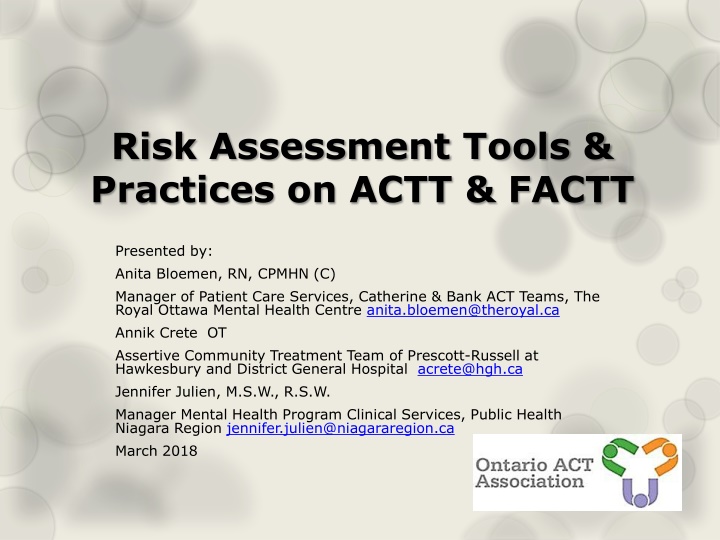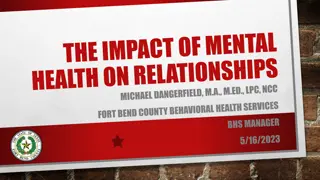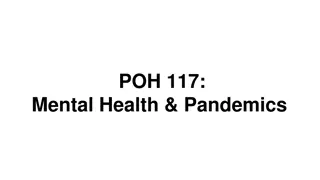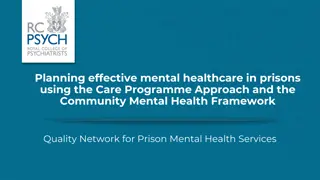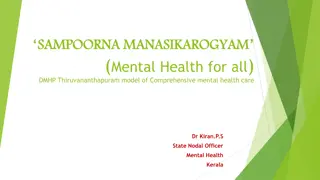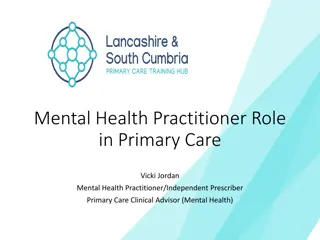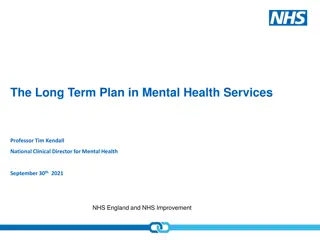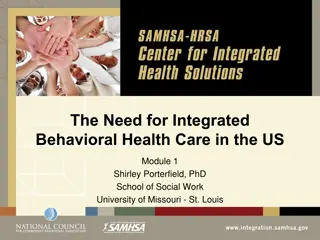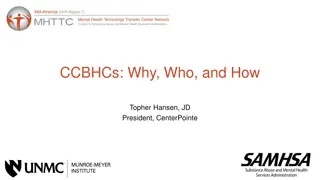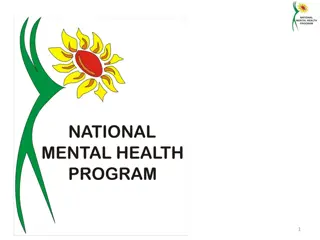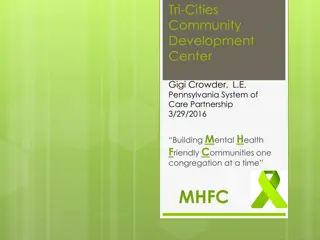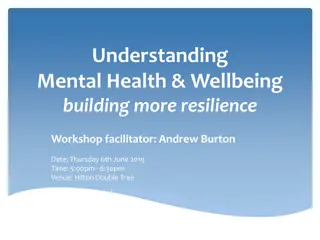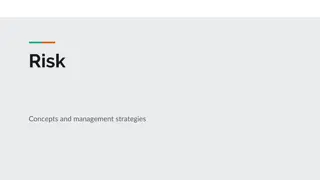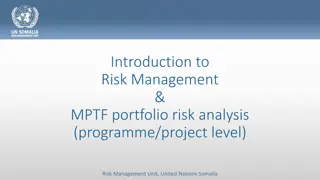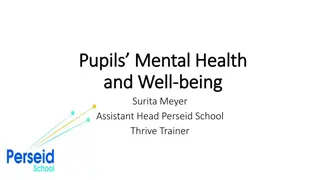Risk Assessment Tools and Practices in Community Mental Health Care
In March 2018, Anita Bloemen, Annik Crete, and Jennifer Julien presented insights on risk assessment practices in Assertive Community Treatment Teams. The focus was on enhancing frontline staff's comfort and confidence in delivering care outside hospital settings, emphasizing the need for ongoing awareness and education on risk management. The presentation covered topics such as daily risk management practices, the use of formal risk assessment tools, and processes for reassessment, aiming to improve safety and care standards within community mental health services.
Download Presentation

Please find below an Image/Link to download the presentation.
The content on the website is provided AS IS for your information and personal use only. It may not be sold, licensed, or shared on other websites without obtaining consent from the author.If you encounter any issues during the download, it is possible that the publisher has removed the file from their server.
You are allowed to download the files provided on this website for personal or commercial use, subject to the condition that they are used lawfully. All files are the property of their respective owners.
The content on the website is provided AS IS for your information and personal use only. It may not be sold, licensed, or shared on other websites without obtaining consent from the author.
E N D
Presentation Transcript
Risk Assessment Tools & Practices on ACTT & FACTT Presented by: Anita Bloemen, RN, CPMHN (C) Manager of Patient Care Services, Catherine & Bank ACT Teams, The Royal Ottawa Mental Health Centre anita.bloemen@theroyal.ca Annik Crete OT Assertive Community Treatment Team of Prescott-Russell at Hawkesbury and District General Hospital acrete@hgh.ca Jennifer Julien, M.S.W., R.S.W. Manager Mental Health Program Clinical Services, Public Health Niagara Region jennifer.julien@niagararegion.ca March 2018
This is an important topic There has been a lot of conversation and focus around the topic of risk Important for front-line staff to feel safe, comfortable and confident providing care in the community To increase awareness and education of current risk practices Nature of ACT and Fact front line workers are not within hospital walls
Intro: TAC Sub-committee on Risk Assessment and Safety Identified need to research best practices regarding risk assessments and safety training for Act and Fact clinicians. Early stages still where we ve, shared curent practices with in our own teams and identified some topics needing more research Present what we ve found so far
Presentation Outline Survey : share results from the responding ACT team s Our own experience and knowledge The safety huddle HARM tool Training for front line staff, what s out there Conclusion: Where to go from here
Question #1: What practices does your team have in place to consider &/or manage risk day to day? Daily Practices to Manage Risk 22 25 17 20 12 11 15 10 5 0 # Respondents
Question #2: Does your team use a formal tool for assessment of risk? Use of Risk Assessment Tools 13 14 9 12 10 8 6 4 2 0 No Yes # Respondents
Question #3: Does your team have a process for reassessment? Reassessment Processes 19 20 15 10 5 5 0 No Yes # Respondents
Question #4: Does your team currently have specific training for managing violence &/or aggression? -None (2) -Safety in the Workplace (1) -Non-Violent Crisis Intervention (18) -Risk Safety Training (1) -Community Workers Safety Strategies CTI (1) -ASSIST (2) -Trauma Informed (1) -Sharpe Edge (2) -OMEGA (1)
Question #5: If possible, please provide approximate number of incidents of physical aggression towards staff in last 1-5yrs. Estimated # of Incidents of Physical Aggression 12 10 8 6 4 2 0 # Respondents
What are Safety Huddles A structured team communication process initiated at routine intervals Allows for a consistent approach to discuss, plan and follow up patient, staff, health and environmental concerns (including violence) in our work environment. Provides the team with a recorded day by day snapshot of risk that requires follow up, or has been managed.
What could it look like. MONDAY TUESDAY WEDNESDAY THURSDAY FRIDAY SATURDAY SUNDAY DD/ MM/ YYYY DD/ MM/ YYYY DD/ MM/ YYYY DD/ MM/ YYYY DD/ MM/ YYYY DD/ MM/ YYYY DD/ MM/ YYYY Date and Time: Safety Huddle facilitator initial Evening/ on call staff to initial 1. Look back Were there any patient (P), staff(S), and environmental (E) safety concerns over the past 24 hours? Circle the letter. Follow up What can we do to address the concerns? Who are the leads? Document in the communication box. Concerns Y N P S E Concerns Y N P S E Concerns Y N P S E Concerns Y N P S E Concerns Y N P S E Concerns Y N P S E Concerns Y N P S E 1. Look ahead Do you anticipate any patient, staff, health and/or environmental safety concerns over the next 24 hours? Follow up What can we do to address the concerns? Who are the leads? Document in the communication box. Concerns Y N P S E Concerns Y N P S E Concerns Y N P S E Concerns Y N P S E Concerns Y N P S E Concerns Y N P S E Concerns Y N P S E 1. Admissions/Discharges/Transfers Initials of patient. 1. Weekend /Evening Worker- Community on call daily check in and out and as required plan for support needed prn due to patient acuity, and or risk management over weekend Concerns Y N Concerns Y N Concerns Y N Concerns Y N Concerns Y N Concerns Y N Concerns Y N
DATE Team Communication boxes ISSUE/ACTION ITEMS/ TEAM PLAN DATE FOR REVIEW/COMPLETED DD/ MM/ YYYY AIS Score IDENTIFIED DD/ MM/ YYYY Lead: Review date: Completed/date Lead: Review date: Completed/date Lead: Review date: Completed/date Lead: Review date: Completed/date No Drive List Review date Environmental concern Review date
How get everyone speaking the same language .. Team consensus can be a challenge with regards to incidents and behaviours. We all bring our own backgrounds and experiences which impact on our perceptions and day to day interactions. Solution for our program/community has been using the Aggressive Incident Scale Courtesy of St Joseph's Healthcare Hamilton.
Hamilton Anatomy of Risk Management (HARM)
What is the HARM St. Joseph s Healthcare Hamilton Dr. Gary Chaimowitz and Dr. Mini Mamak The HARM is a structured clinical judgment tool that guides discussion regarding risk of violence It combines both past, present and future factors to assess risk as reflected in the literature.
Versions of HARM Multiple Versions of the HARM Forensic Version Community Version Correctional Version Youth Version Bail Version
HARM in Niagara Niagara ACT teams received initial training in 2013 and then again in 2015. Standardized Practice Common Language Education in Assessing Risk Guide Discussion Increase Confidence and Comfort in assessing risk
Implementation of HARM Implementation Plan Training half day for all staff both times Assessed all clients to have a baseline HARMs Assess all new ACT clients Re-evaluated Q 6 months or as needed (ie. Change in presentation) Team discussion of HARM at Clinical Meetings or as necessary (ie. Morning meeting)
HARM-CV Example
Advantages of HARM Easy to use Comprehensive (past, current, future) Team approach Preventative measures (double visits, public visits) Provides rationale and evidence for treatment planning around risk (risk management) Standardized Evidence based, strong research and tested for community use. Risk assessment tool drives risk management strategies
HARM Challenges Paper format Electronic Version now available Environmental Risk Factors Team consensus
Contact information Website https://www.ais-harm.com/ Contact us page Videos Detailed information on each version of the tool
Training for Frontline Staff Aimed at preventing incidents from happening Reducing impact of incidents, limit harm Building consensus and confidence among the team Non-violent Crisis Intervention (NVCI) , de-escalation techniques Safety in the Community training, aimed more for community workers includes enviromental factors OMEGA education and training program, Qu bec Act teams
In summary, for reflection with your teams: Safety committee or a group of people committed to developing a safety culture with in your workplace Look in to formal training according to your needs , adapted to community work Tools to collect static and dynamic data, to identify, mitigate and communicate actual and/or potential risks Ensure daily communication about managing risk in the work enviornement Implement post-incidence response, incident review, support and debriefing
Useful links and Resources: TRAINING: OMEGA education and training program National Centre of Excellence in Mental Health (NCEMH) Douglas (Qu bec ACT teams) List of documentation used for Qu bec ACT teams : http://www.douglas.qc.ca/page/cnesm-documentation-si?locale=en Manual on safety, only available in French: http://www.douglas.qc.ca/uploads/File/cnesm/Guide_%20securite_mai2013.pdf GUIDE ON COMMUNITY SAFETY: Avoiding aggression when working in the community http://asstsas.qc.ca/sites/default/files/publications/documents/Guides_Broch_Depl/B29A_aggression.p df
Continued. Community Workers Safety Strategies workshop delivered by the Canadian training institute http://www.canadiantraininginstitute.com/cwss Non-violent crisis intervention CPI Crisis prevention institute https://www.crisisprevention.com/ Crisis and trauma resource institute https://ca.ctrinstitute.com/workshop-descriptions/dpvs-violence- prevention/ Safe Management Group (online course for 25$) Safe passage: Working in the community http://safemanagement.org/health-care-training-program
Continued. Ministry of labour report: Preventing workplace violence in the healthcare sectorOur health care sector https://www.ontario.ca/page/preventing-workplace-violence-health-care- sector?_ga=2.82363921.66409050.1522000073-997551180.1522000073 Public services Health and safety association: https://workplace-violence.ca/tools/workplace-violence-risk-assessment-wvrat/ An Introduction to PSHSA s Workplace Violence Risk Assessment Tool: Recognizing Hazards and Planning for Prevention (Webinar) https://www.pshsa.ca/product/introduction-pshsas-workplace-violence-risk-assessment-tool- recognizing-hazards-planning-prevention/ Assessing and Communicating the Risk of Workplace Violence (Webinar) https://www.pshsa.ca/product/assessing-communicating-risk-workplace-violence/
